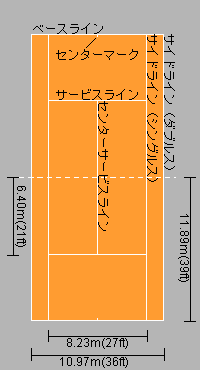Tennis court
|
|
A tennis court is where a game of tennis is played. It is a firm rectangular surface with a low net standing across the center.
| Contents |
Dimensions
The outside dimensions of the playing lines should be as follows: Doubles 36' x 78' (10.97m x 23.77m) Singles 27' x 78' (8.23m x 23.77m)
For tournament play where judges are required, a clear area a minimum of 70' x 130' (21.33m x 39.62m) should be provided. This allows a minimum clear playing area of 60' x 120' (18.28m x 36.57m) with an additional perimeter area for judges as well as a safe overrun area for the players.
A net is stretched across the full width of the court, parallel with the baselines dividing it into two equal ends, each of which is 39 feet (11.89 m) long. The top of the net at the inside face of the posts or supports when used to support a net for singles play on a doubles court should be exactly 42" (1.067m) above the court surface. There should be no obstruction above the top of the net at any point, including at the post. The net should be extended fully so that it fills completely the space between the two posts and be of sufficiently small mesh to prevent the ball passing through. The height of the net should be 3 feet (0.914m.) at the center, where it is held down taut by a strap not more than 2 inches (5cm.) wide and completely white in color.
The lines at the ends of the court are called baselines, and the lines at the sides are the 'singles' and 'doubles' lines. Additional clear space around the court is required in order for players to reach overrun balls.
Two more sets of lines delimit the service courts. Servicelines are parallel with the baselines and the net, 21 feet (6.40 m) from the net on each side, drawn between the two singles sidelines. The center serviceline is parallel with the sidelines, in the center of the court, drawn between the two servicelines. The center serviceline is echoed in a white strap in a vertical orientation in the center of the net. The four service courts are the rectangular areas each delimited by the net, a singles sideline, a serviceline, and the center serviceline.
The service court on the player's right is called the deuce court, while the service court on the left is the advantage court, or ad court. The center of each baseline is marked by a short center mark. All the lines, except those marking the center, are drawn just within the court that they delimit. Thus it is the outer edge of each line that is significant.
Types of tennis courts
There are four main types of courts depending on the materials used for the court surface: clay courts, hard courts, grass courts and indoor courts.
Clay courts
Clay courts are made of crushed shale, stone or brick, and can be either red or green. Clay courts are considered "slow", meaning that the balls bounce relatively high and more slowly, making it more difficult for a player to hit an unreturnable shot. The red clay is slower than the green, or Har-Thru(c) "American" clay. The French Open uses clay courts.
Hard courts
Hard courts, or cement courts, are considered "fast" surfaces, where fast, low bounces keep rallies short, and powerful, hard-serving players have an advantage. The US Open is played on hard courts, while the Australian Open is played on Rebound-Ace which is a type of hardcourt.
Grass courts
Grass courts are the fastest kind of tennis courts, next to hard courts. Grass courts consist of grass grown on very hard-packed soil, similar to golf greens. Grass courts add an additional variable, with bounces depending on how healthy the grass is and how recently it has been mowed. The most famous grass tennis court in the world is undoubtedly the one at Wimbledon. Grass courts tend to favor serve and volley tennis players, such as John McEnroe or Martina Navratilova. Due to high maintenance costs however, grass courts are now rare as they must be watered and mowed often.
Indoor courts
Indoor courts can be made of wood, cement, or 'carpet' also known as astro-turf.
Others
Other types of courts exist as well, and there is no consistent definition of what qualifies as a "hardcourt". Non traditional surfaces are rarely used in competitive tennis.

